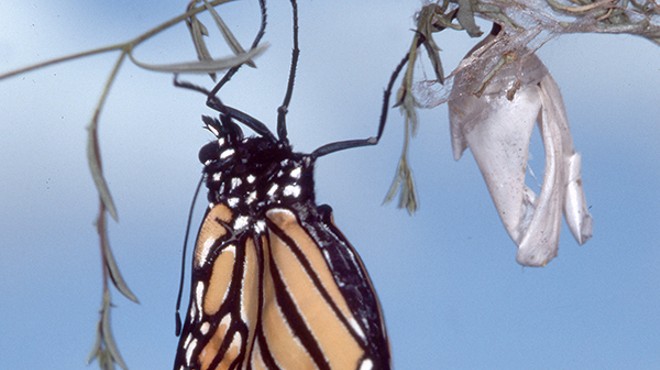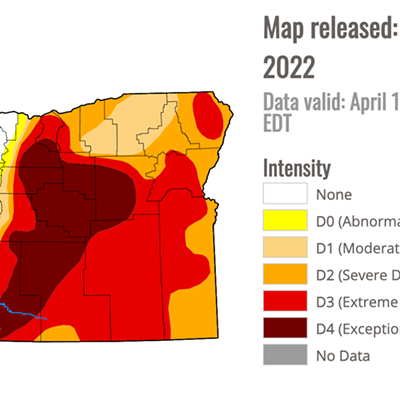Since the recent story I wrote on the plight of the monarch butterfly in which I encouraged the residents of Central Oregon to create monarch waystations, I've been reminded by more than one person that I left out a couple of salient facts about the life history of monarchs: time and metamorphosis.
Thus, regarding the time element, it will require about two years for those milkweed seeds you planted to grow into mature plants that will produce blossoms. In that time, however, you may observe monarchs come through the waystation, stop and smell the milkweed growing and lay eggs on it even before it flowers.
According to some stories I've read about the milkweed butterfly, they are thought to have a type of genetic memory that gives them the ability to "remember" milkweed sites, passing the locations on to the next generation of monarchs coming through to stop and lay eggs where their parents or grandparents might have been.
Near the end of summer, physiological signals trigger the monarch to stop mating and start building body fat. This fat becomes the fuel that delivers energy for the animal to make its incredible journey south.
It is also that same signal (triggered by the position of the sun, air temperature, etc.) that provides the message to begin mating and leave for their summer home, during which time, female monarchs begin putting off pheromones that shout, "Yoo-hoo! Here I am!" and the next generation of monarchs begins.
When one stops and thinks about the beautiful beginning to that next generation of butterflies, it (to me) seems miraculous. The seeds of undeveloped eggs have been stored away all winter in the ovaries of the female, while sperm is tucked away in the male butterfly's reproductive system.
As early as February, these regal butterflies mate and begin their northward journey. The females stop and lay their precious eggs on the underside of a milkweed leaf. This may not be the same species of milkweed, however, that successive generations will use during the flight north. What is the mechanism that prompts the next generation of adults to mate and lay eggs on different species of milkweed? Ah, the wonder of it all.
In about three to eight days (assuming the eggs have been laid on native milkweed), the caterpillar will break forth from its chitin egg capsule, take one whiff of the leaf it's grasping and murmur, "Yum, yum..." and begin chomping its way toward adulthood.
(But, here's where an alien, milkweed-like plant has pulled a dirty trick on monarchs. The Swallow-wort invaders and the Cynanchums are deadly for monarchs in North America. The unsuspecting female monarchs lay their eggs on these relatives of native vining milkweed because the plants produce stimuli similar to real milkweed. However, once the eggs hatch, the caterpillars are poisoned by the toxicity of this invasive, fake European milkweed.)
The tiny caterpillar that emerges out of the egg is pale green and translucent, and lacks banding coloration or tentacles. It's during this stage of growth that the caterpillar begins to use the circular motion while eating milkweed that prevents the flow of latex from the leaf that could entrap it.
After four of five instars (shedding its old skin—literally growing out of its britches), the new, larger caterpillar finally breaks out. It's relatively large compared to when it started out in life, and about to come to the end of the trail; it's 25 to 45 mm long, 5 to 8 mm wide and 2,000 times larger than the egg it came from.
The stage is now set for the caterpillar to change from one kind of organism to another. It stops feeding and searches for a pupation site and attaches itself securely to a horizontal surface, using a silk pad and hanging upside down, resembling the letter J. It then molts one last time into a jewel-like opaque, blue-green chamber (called a chrysalis) decorated with small gold dots, inside of which is the pupa.
(Note: Butterflies go through metamorphosis in the chrysalis, while moths do it in a cocoon.)
This is it: metamorphosis. Everything inside the pupa breaks down into a biological soup, the caterpillar vanishes, oxygen is now absorbed from the air around the chrysalis, and no body parts are recognizable, but what is there is still supporting the essence of life.
That green, primordial genetic soup soon begins to rearrange itself into what will be an adult butterfly: three distinctive body parts, a new way of breathing, an entirely new digestive system, a new way of eating different foods, through a tube, are now re-formed.
Antennae are eyes which allow the insect to see colors. Its wings are coated with shimmering scales that give the monarch its beauty and its scientific family name, Lepidoptera. At the end of metamorphosis, the adult emerges from the chrysalis, expands, dries its wings and flies away.
Monarch metamorphosis from egg to adult occurs during the warm summer temperatures in as little as 25 days, extending to as many as seven weeks during cool spring conditions. During the development, however, both larva and their milkweed hosts are vulnerable to weather extremes, wildfire, predators, parasites and diseases; commonly fewer than 10 percent of monarch eggs and caterpillars survive.
However, one of the beautiful things about creating a monarch waystation, with milkweed and butterfly nectar plants, will be the opportunity to witness the emergence of the adult butterfly from the chrysalis. So, what are you waiting for?




























